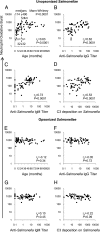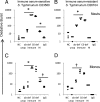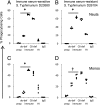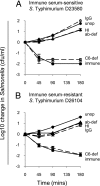Importance of antibody and complement for oxidative burst and killing of invasive nontyphoidal Salmonella by blood cells in Africans
- PMID: 20133627
- PMCID: PMC2840319
- DOI: 10.1073/pnas.0910497107
Importance of antibody and complement for oxidative burst and killing of invasive nontyphoidal Salmonella by blood cells in Africans
Abstract
Bacteremia caused by nontyphoidal strains of Salmonella is endemic among African children. Case-fatality rates are high and antibiotic resistance increasing, but no vaccine is currently available. T cells are important for clearance of Salmonella infection within macrophages, but in Africa, invasive Salmonella disease usually manifests in the blood and affects children between 4 months and 2 y of age, when anti-Salmonella antibody is absent. We have previously found a role for complement-fixing bactericidal antibody in protecting these children. Here we show that opsonic activity of antibody and complement is required for oxidative burst and killing of Salmonella by blood cells in Africans. Induction of neutrophil oxidative burst correlated with anti-Salmonella IgG and IgM titers and C3 deposition on bacteria and was significantly lower in African children younger than 2 y compared with older children. Preopsonizing Salmonella with immune serum overcame this deficit, indicating a requirement for antibody and/or complement. Using different opsonization procedures, both antibody and complement were found to be necessary for optimal oxidative burst, phagocytosis and killing of nontyphoidal Salmonella by peripheral blood cells in Africans. Although most strains of African nontyphoidal Salmonella can be killed with antibody and complement alone, phagocytes in the presence of specific antibody and complement can kill strains resistant to killing by immune serum. These findings increase the likelihood that an antibody-inducing vaccine will protect against invasive nontyphoidal Salmonella disease in African children.
Conflict of interest statement
The authors declare no conflict of interest.
Figures




References
-
- Gordon MA, et al. Epidemics of invasive Salmonella enterica serovar Enteritidis and S. enterica Serovar Typhimurium infection associated with multidrug resistance among adults and children in Malawi. Clin Infect Dis. 2008;46:963–969. - PubMed
-
- Berkley JA, et al. Bacteremia among children admitted to a rural hospital in Kenya. N Engl J Med. 2005;352:39–47. - PubMed
-
- Graham SM, et al. Nontyphoidal Salmonella infections of children in tropical Africa. Pediatr Infect Dis J. 2000;19:1189–1196. - PubMed
-
- Molyneux EM, et al. The outcome of non-typhoidal salmonella meningitis in Malawian children, 1997-2006. Ann Trop Paediatr. 2009;29:13–22. - PubMed
Publication types
MeSH terms
Substances
Grants and funding
LinkOut - more resources
Full Text Sources
Medical
Miscellaneous

